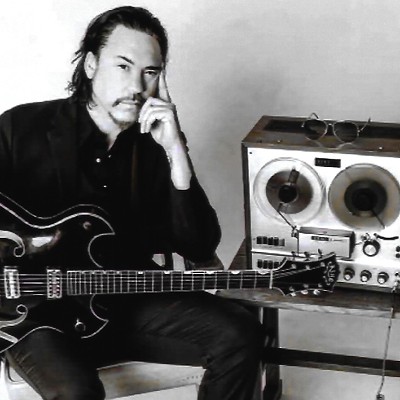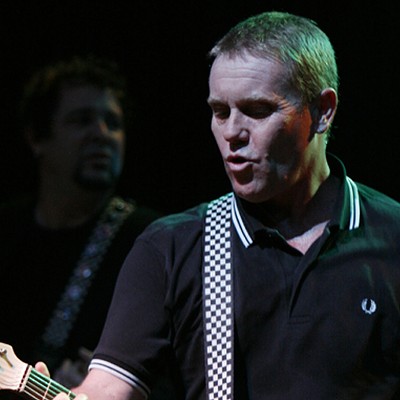Support Us
Houston's independent source of
local news and culture
account
- Welcome,
Insider - Login
- My Account
- My Newsletters
- Contribute
- Contact Us
- Sign out
Inquiring Minds: An Hour With The Red Krayola Mastermind Mayo Thompson
Chris Gray February 3, 2010 1:30PM
[
{
"name": "Related Stories / Support Us Combo",
"component": "11591218",
"insertPoint": "4",
"requiredCountToDisplay": "4"
},{
"name": "Air - Billboard - Inline Content",
"component": "11591214",
"insertPoint": "2/3",
"requiredCountToDisplay": "7"
},{
"name": "R1 - Beta - Mobile Only",
"component": "12287027",
"insertPoint": "8",
"requiredCountToDisplay": "8"
},{
"name": "Air - MediumRectangle - Inline Content - Mobile Display Size 2",
"component": "11591215",
"insertPoint": "12",
"requiredCountToDisplay": "12"
},{
"name": "Air - MediumRectangle - Inline Content - Mobile Display Size 2",
"component": "11591215",
"insertPoint": "4th",
"startingPoint": "16",
"requiredCountToDisplay": "12"
}
,{
"name": "RevContent - In Article",
"component": "12527128",
"insertPoint": "3/5",
"requiredCountToDisplay": "5"
}
]
Page 6 of 11
RO: How did you go about composing the music to match each one of these portraits?
MT: All of those people are very familiar to me. My being an American, I happen to know all those characters. Wile E. Coyote, I saw the first Roadrunner cartoon back when they came out. I always liked Wile E. Coyote and thought he was a very sympathetic figure and, you know, one of the most charming villains in film history.
And I also liked Bo Diddley, and I know Bo Diddley wrote a song called 'Roadrunner.' So I started putting two and two together, things like that, you know, just one step after another, that leads to another thing - the 'knock on' effect with ideas. It was about generating something that was familiar.
You know how portraits are - when you go and look at a portrait of somebody you'll see in a museum, and if they were an explorer there'll be a little globe on the table, and they'll have their hand on a book of geography, that kind of stuff. And so it was pretty simple putting together the atmosphere that goes around these kinds of people. Their worlds, so to speak.
Wile E. Coyote's world is his life in the imagination of people. And I thought about Bo Diddley, of course, and Bo Diddley had just passed away not too long before I started working on that thing. I had always liked his music, and I always felt a great deal of sympathy for him, and understanding, because when I hear 'Roadrunner,' which is a little bit different from his jungle thing, I thought, 'That's the pop musician's perennial problem, that the idea is to make something that everybody will like, and to do something that makes a kind of sense.'
So I went online and saw a couple of performances of Bo Diddley performing 'Roadrunner' with his ensemble, and it just struck me how alienated the whole thing was, about how much it wasn't idea-driven, about how it was a project to do something, and to get something that really resonated with the people.
And who knows? Bo Diddley, at the time he did that, I think he was living in New Mexico. Maybe he saw a roadrunner, or maybe he saw the Roadrunner cartoon and thought that it had captured people's imagination and he was going to get him a little piece of that action, he was going to get in on that, so he wrote that tune, and that tune seemed to be good enough to me.
So I rearranged it and added a few little thises and little thats, but it seemed to be an ideal way of portraying Wile E., a good backdrop. And it seemed to capture some of the energy and the frenetic aspect of it, which is something like a cartoon.
So I got that, and I thought of George Bush as being a figure who is intimately associated with the very idea of Texas. I thought, 'Well, that's my turf.' So I borrowed the University of Texas' fight song, which they borrowed from some other tune they borrowed from, you know, the levee song and 'I've Been Working on the Railroad,' and then I had some other music which I had written. Back in the '80s I wrote a piece called 'The New Eyes of Texas' which I had never done anything with, but I had this piece sitting around.
I thought about 'Home, Home on the Range,' which was written in Texas I believe, and 'Red River Valley' and 'Oh Texas, My Texas,' 'The Yellow Rose of Texas' - I just thought of all that Texiana and thought about George Bush, thought about there being a piano in the White House and, you know... it was pretty straightforward, you know what I mean? It was just a game of association.
And Jimmy Carter being from Georgia, you know, 'Georgia On My Mind.' 'Rainy Night In Georgia.' And then 'Dixie's Land,' something - sort of the forbidden, the hot icon, because it's associated with the Confederacy and associated with the old slaveholding South and the contradictions which persist and continue to this time, continue to haunt the whole relation, as we see. So all of that came into it.
At the same time, with John Wayne, I grew up with John Wayne in the movie house. Back in the day in Houston, there used to be a theater on the corner of Main Street and Richmond Avenue that was called the Delman. I lived around the corner from that theater, and I used to go there every Saturday to the movies. I think I probably saw most of the movies that John Wayne was in from the late '40s all the way through the '50s.
John Wayne was a hero to me. He's one of those figures that I just admired and respected. And of course in the '60s, when there was a question of are you a patriot and how does patriotism express itself, and there was some controversy over what counted as a legitimate expression of patriotism and 'Do you love your country?' and 'Would you die for it?', etc. The Green Berets, and all that moment. And John Wayne had always been a conviction player on the side of flying the flag, which is something I understand.
Of course my father's generation, those people went out and fought the war. That was the world I grew up in. I was born in '44, the war ended a year later, no connection I'm sure, but that colored my relationship to John Wayne. And Ad Reinhardt I got to know about when I got to know about art. And Mozart of course I had known about since I was an infant. I've heard his music all my life.
The funny thing about the Mozart piece is that my wife is a molecular biologist. We were living in Scotland at the time and she had a piano. She's also an accomplished pianist, although she doesn't play any more. At one time she had to choose between biology and the piano, and she chose biology.
Anyway, she would come home and sit down at the piano sometimes and play. One evening she came in and started playing this Mozart piece. She was working on some passage of it that didn't quite satisfy her. She's quite technically accomplished, so she was working on the left hand. I heard this figure, and I said, 'Honey, what's that you're playing?' She told me what it was, the name of the piece, and I'd heard it before but just didn't know what the name of it was.
And I said, 'Would you play that again? Just the left hand, and play it slowly.' She did, and it's the motif from 'Paint It, Black' by the Rolling Stones. This is in the second section of Piano Sonata No. 6 in D (sings). The first 32 bars of the second section of the Piano Sonata in D, that is a motif. It changes register and changes around, it doesn't stay the same way it does in the Stones' version of it, but then I thought to myself, 'Brian Jones, surely he heard that. He had piano lessons as a kid and knew Mozart, and that line had always stuck in his head. Who knows?'
So that was an easy association. And it turns out, of course, that Ad Reinhardt always painted all of his pictures black. They're all black. So there's a certain kind of literalism and a kind of associationism, trading in familiarities, some straightforward representation, which is a little bit different from what I've ever done, but like I said I don't like to do the same thing twice. So that's how that stuff came about.
The John Wayne thing, the movie, one of my favorites of his is The Searchers. It's got music by Max Steiner. I think he must be a German émigré who came to America after the war, somebody like Franz Waxman, who wrote for Hitchcock, somebody who was trained in the academy and knew musical tropes very well, and who was able to adapt things, sitting out there in Hollywood and knew this one and knew that one, and one thing led to another and pretty soon he's writing the music to this movie.
So because it's a Western, he's obliged to bring it down to earth at some level, and there's some fairly prosaic music, and I'm sure that he listened to some American music in the same way that, you know, Bartok listened to folk music and stuff like that. When I listened to The Searchers, I thought, 'Well, there's 'Just a Closer Walk With Thee' in there, it's an adaptation from this old spiritual, but it's also the tune to a thousand songs.' So it's deeply ingrained in American culture, and so it seemed to me to be deeply noncontroversial.
Plus, in that setting, you have all the chromatic excitement, which is all the clichés of soundtrack music versus this homely tune, and that kind of thinking.
KEEP THE HOUSTON PRESS FREE...
Since we started the Houston Press, it has been defined as the free, independent voice of Houston, and we'd like to keep it that way. With local media under siege, it's more important than ever for us to rally support behind funding our local journalism. You can help by participating in our "I Support" program, allowing us to keep offering readers access to our incisive coverage of local news, food and culture with no paywalls.
Chris Gray has been Music Editor for the Houston Press since 2008. He is the proud father of a Beatles-loving toddler named Oliver.
Contact:
Chris Gray
Trending Music
- Houston Concert Watch 4/17: Adan Ant, Bad Religion and More
- Latin Grammy Winning Singer-Songwriter Andrés Cepeda Returns to Houston
- Top 10 Butt-Rock Bands of All Time
-
Sponsored Content From: [%sponsoredBy%]
[%title%]

Don't Miss Out
SIGN UP for the latest
Music
news, free stuff and more!
Become a member to support the independent voice of Houston
and help keep the future of the Houston Press FREE
Use of this website constitutes acceptance of our
terms of use,
our cookies policy, and our
privacy policy
The Houston Press may earn a portion of sales from products & services purchased through links on our site from our
affiliate partners.
©2024
Houston Press, LP. All rights reserved.





